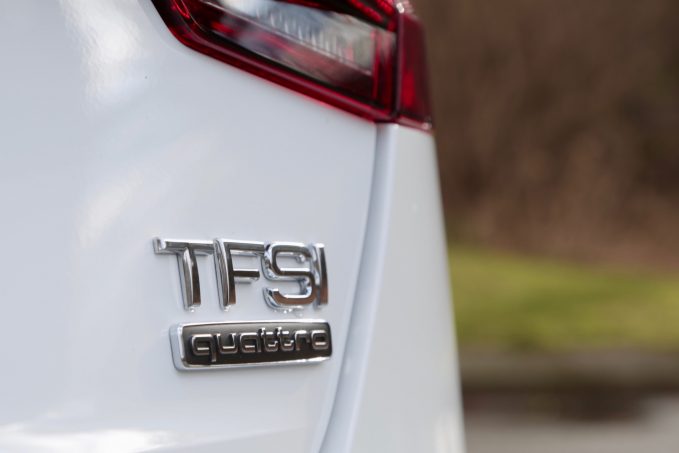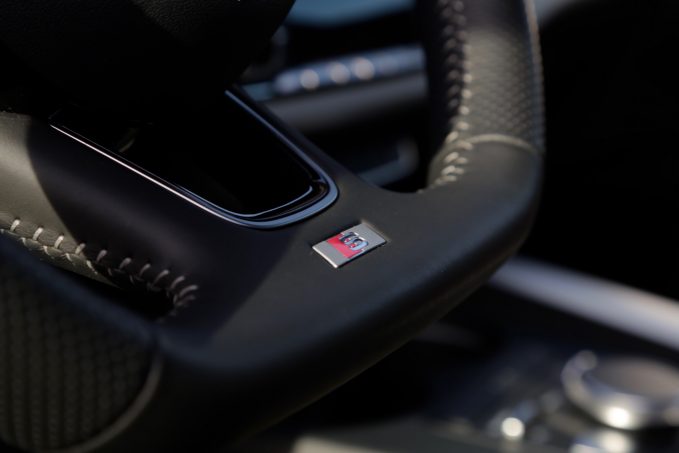With this generation, the Audi A4 might just be going through an existential crisis. A conservatively designed sedan with a luxurious interior and a premium badge on the nose is a luxury car right?
Then why is it that every time I get in and drive, there is something about it that just makes me want to drive a little bit harder, plant my foot when every red turns green, and brake just enough for the front tires to bite, trying to clip the apex on my favorite onramps?
With a couple of transformative options, Audi has turned this A4 into a starter sports sedan.
While the base suspension is no doubt competent and comfortable, our long-term tester is equipped with the Sport suspension, a fixed suspension that is 23 mm lower than the standard ride height, while the wheels are the upgraded 19-inch option. Audi has wisely wrapped them in winter rubber, in this case Continental ContiWinterContact, which manage to preserve as much of the performance as can be expected in a winter tire, and at 9.5 inches wide (245/35R19), there is plenty of grip to go along with the traction provided by Audi’s all-wheel drive and performance-over-comfort ride tuning. Corners and onramps are your friends. Raised manhole covers and potholes, not so much.
Get the Flash Player to see this player.
Although it’s a fairly typical 2.0-liter turbo that we see everywhere in this segment and in the Audi and VW lineup for over a decade, Audi has worked hard to keep it at the forefront in terms of power, efficiency and refinement, its fuel injection system adding multipoint manifold injection to the sequential high-pressure direct injection and “adaptive lambda control” manages excess injection under partial load, as during light highway cruising. Audi is obsessive about controlling the combustion process to maximize efficiency without sacrificing performance, so in addition to direct injection, continuous intake and exhaust camshaft adjustment manage the airflow into and exhaust out of the cylinder, while an electric wastegate actuator and increased compression ratio (9.6:1 to 11.7:1) work in concert with specially adapted combustion chambers, piston recesses, intake ducts and turbocharging. The engine also shuts off when you come to a stop in traffic or at a light, though it rumbles every time it restarts, so it’s not the most refined execution (nor the crudest) of this technology.
With all these updates, the 2.0T in the A4 is now rated at 252 hp, and although the focus of development was clearly efficiency, it has allowed Audi to pack in a more powerful engine that delivers better efficiency (24 mpg city, 31 mpg highway) compared to its predecessor in the same 2.0T quattro configuration (21/30). And although 23-24 mpg that we’ve been seeing since adopting the A4 doesn’t sound great, it has seen a lot of heavy-traffic commutes on freezing cold mornings, so it has not been a recipe for achieving its best fuel consumption. On a couple of longer weekend drives in milder conditions, we saw as high as 29 mpg, so a longer trip is in order to see how it fares in highway cruising.
What does sound great is the engine under full throttle, a gruff rumble that matches its sporty character. It lives up to its soundtrack too, and between the quick-shifting dual-clutch auto and quattro all-wheel drive, it launches to 60 mph in less than 6 seconds. Although it still hesitates slightly when you first press the accelerator (a trait shared with most other VW Group dual-clutch cars), it very quickly finds traction and gets into its power band, its 273 lb-ft of torque available from 1,600 to 4,500 rpm.
SEE MORE: 2017 Audi A4 Long-Term Test Introduction
Features Editor Sami Haj-Assaad had a chance to take the A4 out, and after he got over the technology shock of the interior layout, he got down to the business of driving and came to the same conclusion about the powertrain: “The engine and transmission are well sorted out, and the car responds nicely to inputs. I didn’t find turbo lag to be an issue at all, and the way the AWD spits you out of intersections and onramps is very entertaining.”
The steering offers a bit of both worlds, its default Comfort setting extremely light, though the ratio changes as speed increases for less arm twirling and more direct response. Dial the Drive Select into Dynamic, and the baseline weight increases (perhaps not as much as I’d like), but it’s still variable, so it’s plenty light enough when you’re just crawling through a parking garage hunting for a spot, and even easier when sliding it home with the assistance of the 360-degreee parking cameras, supplemental front and rear views, and even front and rear sonar. It’s damn near impossible to mess up parking in this thing when so equipped.
Get up to speed, and when taking turns at its limits, and the steering takes a firmer set, accurate though lacking in true feedback, but the car is so responsive that it is easily forgiv
en. Out on the highway it is rock solid and easily eats up the miles without wandering all over its lane or getting twitchy from every steering input – just nice, steady, reassuring cruising. However, Sami took a different view of the adaptive steering: “My one complaint about the driving dynamics is the steering, which had an inconsistent feel. Sometimes it felt light, other it seemed heavy, sometimes it needed only a little input, other times it seemed like it needed much more. Maybe I need to spend more time in the different drive modes!”
That’s right Sami, you should totally spend more time in the A4… except that I like it too much to ever give it up. For our next instalment in this long-term test, we’ll see how the A4 2.0T stacks up against a best-seller in the segment, the Mercedes-Benz C-Class.










